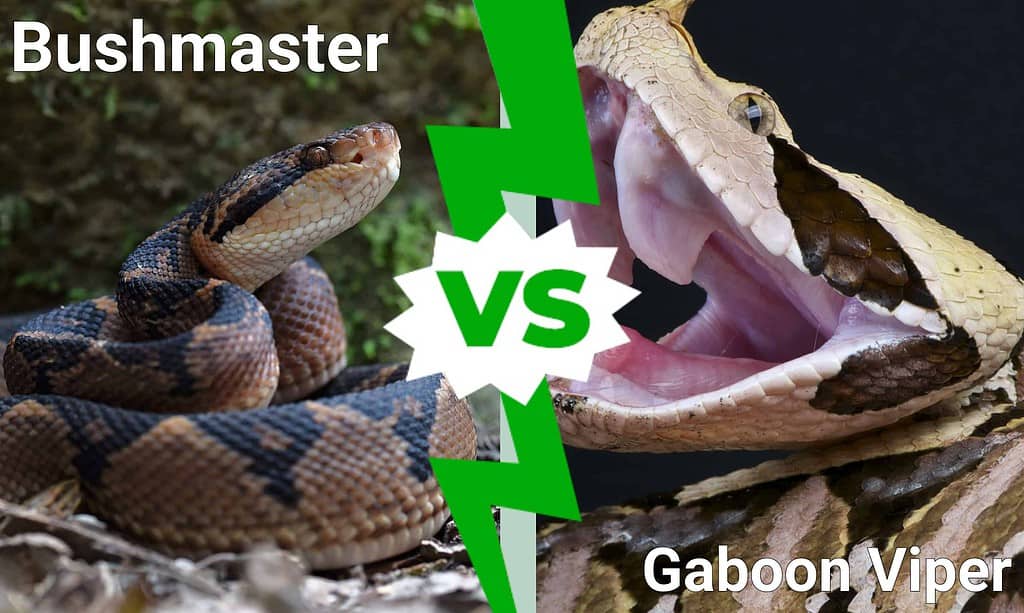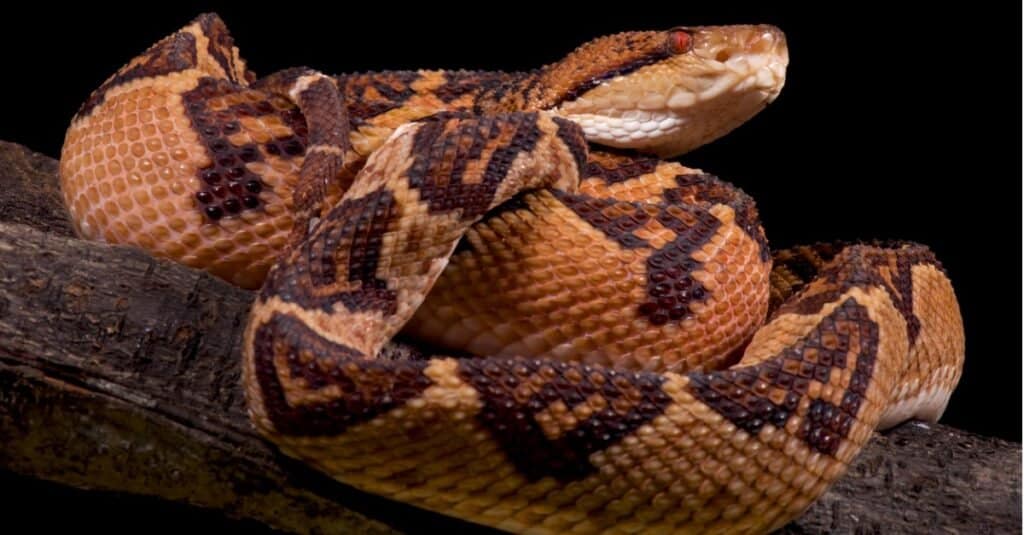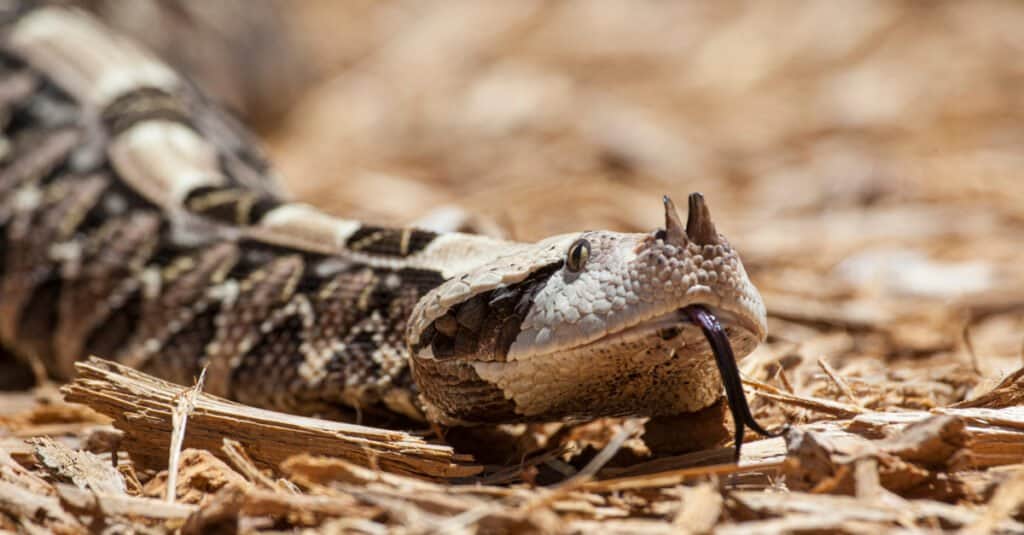The bushmaster and the Gaboon viper are two dangerous snakes known for their sizes and venoms. The Gaboon viper (Bitis gabonica) is a viper of the Viperidae family, while the South American bushmaster (Lachesis muta) is a pit viper.
You could say that all pit vipers are vipers, but not all vipers are pit vipers. Pit vipers are a subfamily (Crotalinae) within the larger Viperidae family and have an added adaptation that true vipers (Viperinae) lack: heat-sensing loreal pits.
Comparing a Bush Master and a Gaboon Viper

| Bushmaster | Gaboon Viper | |
|---|---|---|
| Scientific Name | Lachesis muta | Bitis gabonica |
| Other names | South American bushmaster | Forest puff adder, Gaboon adder |
| Snake Family | Pit viper | Viper |
| Habitat | Forested areas | Rainforests, woodlands, thickets, cashew plantations, grasslands, and bushes |
| Distribution | South America | Africa |
| Subspecies | Two subspecies – Lachesis muta rhombeata and Lachesis muta muta | None |
| Size | 6.6 ft to 12 ft 6.6 to 10 pounds | 4 ft to 7 ft 15.0 to 45 pounds |
| Fang Type | Solenoglyphous fangs | Solenoglyphous fangs Very long fangs that can measure up to 2 inches |
| Hunting style | They hunt using their pits to detect large populations of prey. They lie hidden and wait for their prey to get close before striking. | They strike and hang on to their prey until they are weak or dead from the venom and can be swallowed. |
| Venom composition | Proteolytic venom | Primarily cytotoxic venom |
| Symptoms of envenomation | Bradycardia, hypotension, abdominal pain, vomiting, dizziness and nausea, visual disturbance, diarrhea, etc | Swelling, severe shock, intense pain, blistering, etc |
| Average venom yield | 350 mg | 475 mg |
| Anti-venom? | Yes | Yes |
| Defense Mechanisms | Venom | Venom |
| Temperament/ Behavior | Crepuscular and nocturnal They do not wait to bite when confronted | Primarily nocturnal They are known to be slow in their behavior and movements One of the fastest snake bites known to man |
Key Differences Between the Bushmaster Vs. Gaboon Viper
The key differences between the bushmaster and the Gaboon viper lie in their size, behavior, hunting style, and family.
The Gaboon viper is native to the African continent, while the South American bushmaster is found in South America. Despite their different locations, both snakes favor forested areas and, due to their coloring, they find it easy to blend into their forest surroundings.
The South American bushmaster refers to one of four species of snakes under the bushmaster genus. It is further classified into two subspecies (Lachesis muta rhombeata and Lachesis muta muta), while the Gaboon viper has no subspecies.
Bushmaster Vs. Gaboon Viper: Size

The bushmaster is the longest pit viper in the world, while the Gaboon viper is the largest viper in Africa.
©iStock.com/reptiles4all
Bushmasters are the longest pit vipers in the world. On average, they grow between 78 to 120 inches but have also been known to attain 144 inches (12 feet). Weight-wise, bushmasters measure 6.6 to 10 pounds.
On the other hand, Gaboon vipers can attain a length of 7 feet but measure 32.0 to 51.5 inches (2.7 to 4.3 feet) on average. This makes them much shorter than bushmasters. However, while bushmasters trump Gaboon vipers length-wise, bushmasters are much lighter than Gaboon vipers in weight. Gaboon vipers are regarded as the largest vipers in Africa and weigh from 15.0 to 45 pounds.
Bushmaster Vs. Gaboon Viper: Description & Fang
Bushmasters have broad heads and narrow necks. Unlike snakes whose tails contribute significantly to their total length, these snakes have very short tails. This is one feature they share with Gaboon vipers, who also have really short and thin tails that strike a sharp contrast between their thick bodies. Gaboon vipers have triangular cream or white heads with dark blue-black triangles below each eye. Their necks are also very narrow in contrast with their thick heads.
Color-wise, both species aren’t too different in the sense that their colorings allow them to hide and camouflage in the wild.
The bushmaster has dorsal and ventral scales colored reddish, yellowish, or grayish-brown and is marked with dark brown or black dorsal blotches in triangular shapes.
Gaboon vipers have interocular, dorsal, circumorbital, ventral, lateral, and subcaudal scales and single anal scale. These snakes are light and dark brown with pale rectangular blotches which run down their backs. Between these markings are black hourglass markings with yellow edges, as well as a pair of “horns” on their nostrils.
Both snakes, being vipers, have solenoglyphous fangs. These fangs are hollow, hinged, and designed to inject their venom as deeply as possible, just like hypodermic needles. Solenoglyphous fangs transmit venom from the snakes into their prey faster than any other fang. They are the longest and most dangerous fangs found in snakes. Gaboon vipers’ fangs are much longer than bushmasters’ and measure up to 2 inches. This is massive considering that most snakes have fangs shorter than 1 inch.
Bushmaster Vs. Gaboon Viper Hunting Style & Defense Mechanisms
Both snakes attack and defend themselves using only their venoms. They do not constrict or produce musk, which is a good thing, considering how smelly musk is. Bushmasters hunt using their pits to detect large populations of prey. Their infrared vision enables them to lie hidden and wait for their prey to get close enough to strike. They are ambush predators who lie in wait for multiple weeks.
Gaboon vipers are also ambush predators. They hide or camouflage, waiting for their prey to come close enough for them to strike. However, they sometimes actively hunt in the early hours of the evening. Most snakes with solenoglyphous fangs only hold on to their prey until they’re done injecting their venom. However, Gaboon vipers hold onto their prey until they are weak or dead from the venom and can be eaten.
Bushmaster Vs. Gaboon Viper Venom

The Gaboon viper’s venom is strong enough to kill six people at once.
©Danita Delimont/Shutterstock.com
Bushmasters and Gaboon vipers are two extremely venomous snakes that produce extremely high amounts of venom, but the latter are more venomous. Not only is their venom more toxic, but they also produce larger amounts of venom than bushmasters.
According to Ernst and Zug (1996), bushmasters can produce up to 500mg of venom and need only 2.04mg/pound of the victim’s weight to kill them. This means a person weighing 150 pounds would die from 306 mg of venom.
Gaboon vipers, on the other hand, can kill a human with about 90-100 mg of venom. Considering that they can produce up to 600mg of venom, they are strong enough to kill six humans with a single bite!
The photo featured at the top of this post is © Stu Porter/Shutterstock.com
Discover the "Monster" Snake 5X Bigger than an Anaconda
Every day A-Z Animals sends out some of the most incredible facts in the world from our free newsletter. Want to discover the 10 most beautiful snakes in the world, a "snake island" where you're never more than 3 feet from danger, or a "monster" snake 5X larger than an anaconda? Then sign up right now and you'll start receiving our daily newsletter absolutely free.
Thank you for reading! Have some feedback for us? Contact the AZ Animals editorial team.






